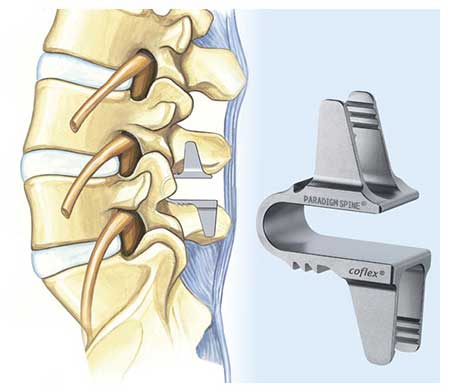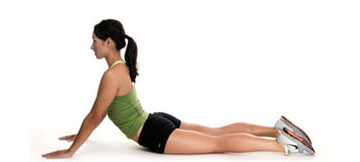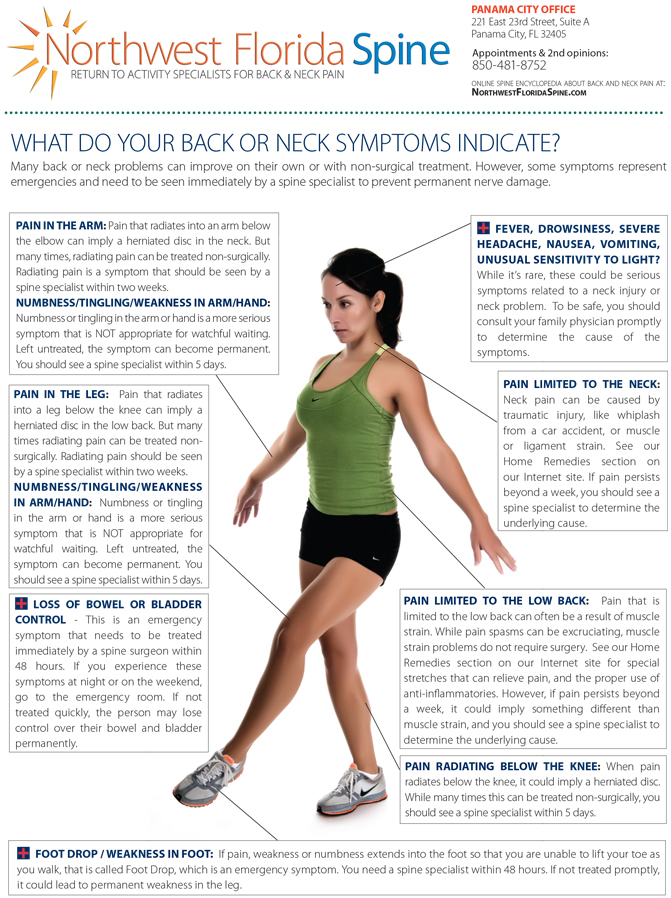Coflex® — An Alternative to Lumbar Fusion
Northwest Florida Spine helps people releive back pain and preserve normal spinal motion using new technology for the low back
It’s estimated that about 2 million Americans suffer from lumbar stenosis, which is a narrowing of the spinal canal that typically appears as a person ages. This narrowing of the spinal canal can be especially problematic for those in their fifties and sixties, causing numbness and weakness in a leg when it’s related to a vertebral level in the low back. The stenosis symptoms appear in an arm and hand if the stenosis is in the neck area.
One indication that these symptoms are linked to stenosis is that they worsen when the person arches their back into extension. Similarly, those with spinal stenosis may have difficulty with walking and standing up for long time periods.
Traditional treatments for stenosis can include physical therapy and anti-inflammatories for a period of time to see if that resolves the symptoms without surgery. However, because the bones in the vertebrae are constricting down on the spinal canal — much like a ring constricting on a swollen finger — a decompression surgery is often required to relieve symptoms of stenosis.

A new implant called Coflex uses an interlaminar stabilization device to relieve symptoms of stenosis. The Coflex device is a single-piece titanium implant that the surgeon inserts into the back of the spine. The Coflex device is strong and flexible which can support the vertebrae in the spine without fusing bones together. The issue with a traditional spinal fusion is that it locks the vertebrae together which reduces the normal motion of the vertebrae and can cause other discs in the spine to degenerate or herniate.
The Coflex device comes in five sizes to fit most patients. The surgeon implants the device at the back of the vertebrae after performing a surgical decompression. Some surgeons do the procedure in a surgery center in day surgery with the patient going home later the same afternoon to recover in the comfort of their own home.
The Coflex Interlaminar Technology is used in one- or two-level lumbar stenosis in the lumbar spine for those who have tried least six months of non-operative care. According to the implant manufacturer, Paradigm Spine, the coflex interlaminar stabilization device has been used in over 60 countries worldwide, and has been implanted over 163,000 times globally.
Coflex vs. Fusion
To address the instability created by decompression, some spine surgeons would otherwise do a spinal fusion to support the spine. The problem with fusion is that multiple pieces of hardware and bone graft are required, and the recovery process can be long and difficult.
The benefits of Coflex surgery include:
- Leg and back pain relief
- Less time in the operating room, less blood loss, and less days in the hospital
- Faster relief of symptoms and quicker recovery
- Maintenance of range of motion at both treated and adjacent segments
How Coflex surgery is performed
After the spine surgeon performs the decompression, the Coflex device is inserted through a minimal incision. The Coflex device supports the facet joints in the spine that contribute to leg and back pain symptoms. Patients who suffer from both leg and back pain from lumbar spinal stenosis are the typical candidates for Coflex.
During decompression surgery, the spine surgeon removes the bony elements that are constricting the spine and putting pressure on the spinal nerves. However, removing this bone may cause the spine to become somewhat unstable. The Coflex implant after decompression is designed to keep your spine stable.
Clinical outcomes related to Coflex
Clinical outcome data has been collected from two prospective randomized studies against two treatment options (decompression alone and decompression with fusion) across two countries (U.S. and Germany). The European study of Coflex over a two-year trial were published in the Journal of Neurosurgery Spine, the official journal of the American Association of Neurological Surgeons. A total of 225 patients, across seven European sites, were enrolled in the study with 91% follow up at two years. The study authors concluded that decompression with Coflex extended the benefits of a decompression procedure compared to just decompression alone.
Surgeons note that the Coflex implant is designed to complement spinal decompression surgery rather than replace it. Coflex is designed to stabilize the spine after the decompression procedure, reducing pain and improving function. According to the implant manufacturer, patients who receive decompression without the addition of the Coflex implant, are twice as likely to need a future surgery or procedure.
Home Remedy Book

As a community service, Northwest Florida Spine mails out a free 36-page Home Remedy Book with customized stretches that can relieve some back and neck pain symptoms. Enter your name and address and we will mail you a copy.
Back to Life Journal

Download our free 16-page Back to Life Journal that shows how to get back to golf, tennis, hiking and more with home remedies. Insert your email to subscribe and download.
Symptoms Chart
Some symptoms can become permanent if you don’t see the physician with in 24 hours. Find out when you can use “watchful waiting” and when you have an emergency symptom.
Exercise Library

What do exercises have to do with relieving pain? Research in sports medicine and spine care exercises have shown to help relieve joint, ligament, muscle problems in the legs, arms, neck and back and increase range of motion.
Need an Appointment?
Dr. Michael Rohan, Jr. is a board certified orthopedic surgeon who is fellowship-trained in spine surgery, the highest level of medical education in the U.S. For over 10 years, Dr. Michael Rohan, Jr. had a prominent spine center on the Florida Gulf Coast with offices in Panama City and Destin before expanding his practice with a new spine care location in Middleburg in Clay County, Florida, a suburb of Jacksonville in Northern Florida. The Jacksonville practice location is convenient to patients from other cities like St. Augustine, Gainesville, Palm Coast, Daytona Beach, and Duval County. Other patients travel from South Georgia cities like Brunswick, GA; Waycross, GA; and coastal locations like Jekyll Island and Savannah. If you’ve been told you need spine surgery, it can be beneficial to get a second opinion for spine surgery from a spine surgeon who specializes in minimally invasive spine surgery and artificial disc replacement.
Disclaimer: Internet Explorer is now obsolete and has been replaced by Microsoft. If you are viewing in Internet Explorer 8 or older, you will need to update your browser by Clicking here.

